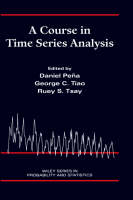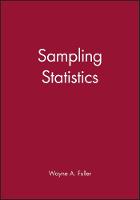Course in Time Series Analysis
 -15%
portes grátis
-15%
portes grátis
Course in Time Series Analysis
Pena, Daniel; Tiao, George C.; Tsay, Ruey S.
John Wiley & Sons Inc
12/2000
496
Dura
Inglês
9780471361640
15 a 20 dias
794
Descrição não disponível.
1. Introduction 1
D. Pena and G. C. Tiao
1.1. Examples of time series problems, 1
1.1.1. Stationary series, 2
1.1.2. Nonstationary series, 3
1.1.3. Seasonal series, 5
1.1.4. Level shifts and outliers in time series, 7
1.1.5. Variance changes, 7
1.1.6. Asymmetric time series, 7
1.1.7. Unidirectional-feedback relation between series, 9
1.1.8. Comovement and cointegration, 10
1.2. Overview of the book, 10
1.3. Further reading, 19
PART I BASIC CONCEPTS IN UNIVARIATE TIME SERIES
2. Univariate Time Series: Autocorrelation, Linear Prediction, Spectrum, and State-Space Model 25
G. T. Wilson
2.1. Linear time series models, 25
2.2. The autocorrelation function, 28
2.3. Lagged prediction and the partial autocorrelation function, 33
2.4. Transformations to stationarity, 35
2.5. Cycles and the periodogram, 37
2.6. The spectrum, 42
2.7. Further interpretation of time series acf, pacf, and spectrum, 46
2.8. State-space models and the Kalman Filter, 48
3. Univariate Autoregressive Moving-Average Models 53
G. C. Tiao
3.1. Introduction, 53
3.1.1. Univariate ARMA models, 54
3.1.2. Outline of the chapter, 55
3.2. Some basic properties of univariate ARMA models, 55
3.2.1. The o and TT weights, 56
3.2.2. Stationarity condition and autocovariance structure o f z ? 58
3.2.3. The autocorrelation function, 59
3.2.4. The partial autocorrelation function, 60
3.2.5. The extended autocorrelaton function, 61
3.3. Model specification strategy, 63
3.3.1. Tentative specification, 63
3.3.2. Tentative model specification via SEACF, 67
3.4. Examples, 68
4. Model Fitting and Checking, and the Kalman Filter 86
G. T. Wilson
4.1. Prediction error and the estimation criterion, 86
4.2. The likelihood of ARMA models, 90
4.3. Likelihoods calculated using orthogonal errors, 94
4.4. Properties of estimates and problems in estimation, 98
4.5. Checking the fitted model, 101
4.6. Estimation by fitting to the sample spectrum, 104
4.7. Estimation of structural models by the Kalman filter, 105
5. Prediction and Model Selection 111
D. Pefia
5.1. Introduction, 111
5.2. Properties of minimum mean-square error prediction, 112
5.2.1. Prediction by the conditional expectation, 112
5.2.2. Linear predictions, 113
5.3. The computation of ARIMA forecasts, 114
5.4. Interpreting the forecasts from ARIMA models, 116
5.4.1. Nonseasonal models, 116
5.4.2. Seasonal models, 120
5.5. Prediction confidence intervals, 123
5.5.1. Known parameter values, 123
5.5.2. Unknown parameter values, 124
5.6. Forecast updating, 125
5.6.1. Computing updated forecasts, 125
5.6.2. Testing model stability, 125
5.7. The combination of forecasts, 129
5.8. Model selection criteria, 131
5.8.1. The FPE and AIC criteria, 131
5.8.2. The Schwarz criterion, 133
5.9. Conclusions, 133
6. Outliers, Influential Observations, and Missing Data 136
D. Pena
6.1. Introduction, 136
6.2. Types of outliers in time series, 138
6.2.1. Additive outliers, 138
6.2.2. Innovative outliers, 141
6.2.3. Level shifts, 143
6.2.4. Outliers and intervention analysis, 146
6.3. Procedures for outlier identification and estimation, 147
6.3.1. Estimation of outlier effects, 148
6.3.2. Testing for outliers, 149
6.4. Influential observations, 152
6.4.1. Influence on time series, 152
6.4.2. Influential observations and outliers, 153
6.5. Multiple outliers, 154
6.5.1. Masking effects, 154
6.5.2. Procedures for multiple outlier identification, 156
6.6. Missing-value estimation, 160
6.6.1. Optimal interpolation and inverse autocorrelation function, 160
6.6.2. Estimation of missing values, 162
6.7. Forecasting with outliers, 164
6.8. Other approaches, 166
6.9. Appendix, 166
7. Automatic Modeling Methods for Univariate Series 171
V. Gomez and A. Maravall
7.1. Classical model identification methods, 171
7.1.1. Subjectivity of the classical methods, 172
7.1.2. The difficulties with mixed ARMA models, 173
7.2. Automatic model identification methods, 173
7.2.1. Unit root testing, 174
7.2.2. Penalty function methods, 174
7.2.3. Pattern identification methods, 175
7.2.4. Uniqueness of the solution and the purpose of modeling, 176
7.3. Tools for automatic model identification, 177
7.3.1. Test for the log-level specification, 177
7.3.2. Regression techniques for estimating unit roots, 178
7.3.3. The Hannan-Rissanen method, 181
7.3.4. Liu's filtering method, 185
7.4. Automatic modeling methods in the presence of outliers, 186
7.4.1. Algorithms for automatic outlier detection and correction, 186
7.4.2. Estimation and filtering techniques to speed up the algorithms, 190
7.4.3. The need to robustify automatic modeling methods, 191
7.4.4. An algorithm for automatic model identification in the presence of outliers, 191
7.5. An automatic procedure for the general regression-ARIMA model in the presence of outlierw, special effects, and, possibly, missing observations, 192
7.5.1. Missing observations, 192
7.5.2. Trading day and Easter effects, 193
7.5.3. Intervention and regression effects, 194
7.6. Examples, 194
7.7. Tabular summary, 196
8. Seasonal Adjustment and Signal Extraction Time Series 202
V. Gomez and A. Maravall
8.1. Introduction, 202
8.2. Some remarks on the evolution of seasonal adjustment methods, 204
8.2.1. Evolution of the methodologic approach, 204
8.2.2. The situation at present, 207
8.3. The need for preadjustment, 209
8.4. Model specification, 210
8.5. Estimation of the components, 213
8.5.1. Stationary case, 215
8.5.2. Nonstationary series, 217
8.6 Historical or final estimator, 218
8.6.1. Properties of final estimator, 218
8.6.2. Component versus estimator, 219
8.6.3. Covariance between estimators, 221
8.7. Estimators for recent periods, 221
8.8. Revisions in the estimator, 223
8.8.1. Structure of the revision, 223
8.8.2. Optimality of the revisions, 224
8.9. Inference, 225
8.9.1. Optical Forecasts of the Components, 225
8.9.2. Estimation error, 225
8.9.3. Growth rate precision, 226
8.9.4. The gain from concurrent adjustment, 227
8.9.5. Innovations in the components (pseudoinnovations), 228
8.10. An example, 228
8.11. Relation with fixed filters, 235
8.12. Short-versus long-term trends; measuring economic cycles, 236
PART II ADVANCED TOPICS IN UNIVARIATE TIME SERIES
9. Heteroscedastic Models
R. S. Tsay
9.1. The ARCH model, 250
9.1.1. Some simple properties of ARCH models, 252
9.1.2. Weaknesses of ARCH models, 254
9.1.3. Building ARCH models, 254
9.1.4. An illustrative example, 255
9.2. The GARCH Model, 256
9.2.1. An illustrative example, 257
9.2.2. Remarks, 259
9.3. The exponential GARCH model, 260
9.3.1. An illustrative example, 261
9.4. The CHARMA model, 262
9.5. Random coefficient autoregressive (RCA) model, 263
9.6. Stochastic volatility model, 264
9.7. Long-memory stochastic volatility model, 265
10. Nonlinear Time Series Models: Testing and Applications 267
R. S. Tsay
10.1. Introduction, 267
10.2. Nonlinearity tests, 268
10.2.1. The test, 268
10.2.2. Comparison and application, 270
10.3. The Tar model, 274
10.3.1. U.S. real GNP, 275
10.3.2. Postsample forecasts and discussion, 279
10.4. Concluding remarks, 282
11. Bayesian Time Series Analysis 286
R. S. Tsay
11.1. Introduction, 286
11.2. A general univariate time series model, 288
11.3. Estimation, 289
11.3.1. Gibbs sampling, 291
11.3.2. Griddy Gibbs, 292
11.3.3. An illustrative example, 292
11.4. Model discrimination, 294
11.4.1. A mixed model with switching, 295
11.4.2. Implementation, 296
11.5. Examples, 297
12 Nonparametric Time Series Analysis: Nonparametric Regression, Locally Weighted Regression, Autoregression, and Quantile Regression 308
S. Heiler
12.1 Introduction, 308
12.2 Nonparametric regression, 309
12.3 Kernel estimation in time series, 314
12.4 Problems of simple kernel estimation and restricted approaches, 319
12.5 Locally weighted regression, 321
12.6 Applications of locally weighted regression to time series, 329
12.7 Parameter selection, 330
12.8 Time series decomposition with locally weighted regression, 336
13. Neural Network Models 348
K. Hornik and F. Leisch
13.1. Introduction, 348
13.2. The multilayer perceptron, 349
13.3. Autoregressive neural network models, 354
13.3.1. Example: Sunspot series, 355
13.4. The recurrent perceptron, 356
13.4.1. Examples of recurrent neural network models, 357
13.4.2. A unifying view, 359
PART III MULTIVARIATE TIME SERIES
14. Vector ARMA Models 365
G. C. Tiao
14.1. Introduction, 365
14.2. Transfer function or unidirectional models, 366
14.3. The vector ARMA model, 368
14.3.1. Some simple examples, 368
14.3.2. Relationship to transfer function model, 371
14.3.3. Cross-covariance and correlation matrices, 371
14.3.4. The partial autoregression matrices, 372
14.4. Model building strategy for multiple time series, 373
14.4.1. Tentative specification, 373
14.4.2. Estimation, 378
14.4.3. Diagnostic checking, 379
14.5. Analyses of three examples, 380
14.5.1. The SCC data, 380
14.5.2. The gas furnace data, 383
14.5.3. The census housing data, 387
14.6. Structural analysis of multivariate time series, 392
14.6.1. A canonical analysis of multiple time series, 395
14.7. Scalar component models in multiple time series, 396
14.7.1. Scalar component models, 398
14.7.2. Exchangeable models and overparameterization, 400
14.7.3. Model specification via canonical correlation analysis, 402
14.7.4. An illustrative example, 403
14.7.5. Some further remarks, 404
15. Cointegration in the VAR Model 408
5. Johansen
15.1. Introduction, 408
15.1.1. Basic definitions, 409
15.2. Solving autoregressive equations, 412
15.2.1. Some examples, 412
15.2.2. An inversion theorem for matrix polynomials, 414
15.2.3. Granger's representation, 417
15.2.4. Prediction, 419
15.3. The statistical model for / ( l ) variables, 420
15.3.1. Hypotheses on cointegrating relations, 421
15.3.2. Estimation of cointegrating vectors and calculation of test statistics, 422
15.3.3. Estimation of a under restrictions, 426
15.4. Asymptotic theory, 426
15.4.1. Asymptotic results, 427
15.4.2. Test for cointegrating rank, 427
15.4.3. Asymptotic distribution of a and test for restrictions on a, 429
15.5. Various applications of the cointegration model, 432
15.5.1. Rational expectations, 432
15.5.2. Arbitrage pricing theory, 433
15.5.3. Seasonal cointegration, 433
16. Identification of Linear Dynamic Multiinput/Multioutput Systems 436
M. Deistler
16.1. Introduction and problem statement, 436
16.2. Representations of linear systems, 438
16.2.1. Input/output representations, 438
16.2.2. Solutions of linear vector difference equations (VDEs), 440
16.2.3. ARMA and state-space representations, 441
16.3. The structure of state-space systems, 443
16.4. The structure of ARMA systems, 444
16.5. The realization of state-space systems, 445
16.5.1. General structure, 445
16.5.2. Echelon forms, 447
16.6. The realization of ARMA systems, 448
16.7. Parametrization, 449
16.8. Estimation of real-valued parameters, 452
16.9. Dynamic specification, 454
INDEX 457
D. Pena and G. C. Tiao
1.1. Examples of time series problems, 1
1.1.1. Stationary series, 2
1.1.2. Nonstationary series, 3
1.1.3. Seasonal series, 5
1.1.4. Level shifts and outliers in time series, 7
1.1.5. Variance changes, 7
1.1.6. Asymmetric time series, 7
1.1.7. Unidirectional-feedback relation between series, 9
1.1.8. Comovement and cointegration, 10
1.2. Overview of the book, 10
1.3. Further reading, 19
PART I BASIC CONCEPTS IN UNIVARIATE TIME SERIES
2. Univariate Time Series: Autocorrelation, Linear Prediction, Spectrum, and State-Space Model 25
G. T. Wilson
2.1. Linear time series models, 25
2.2. The autocorrelation function, 28
2.3. Lagged prediction and the partial autocorrelation function, 33
2.4. Transformations to stationarity, 35
2.5. Cycles and the periodogram, 37
2.6. The spectrum, 42
2.7. Further interpretation of time series acf, pacf, and spectrum, 46
2.8. State-space models and the Kalman Filter, 48
3. Univariate Autoregressive Moving-Average Models 53
G. C. Tiao
3.1. Introduction, 53
3.1.1. Univariate ARMA models, 54
3.1.2. Outline of the chapter, 55
3.2. Some basic properties of univariate ARMA models, 55
3.2.1. The o and TT weights, 56
3.2.2. Stationarity condition and autocovariance structure o f z ? 58
3.2.3. The autocorrelation function, 59
3.2.4. The partial autocorrelation function, 60
3.2.5. The extended autocorrelaton function, 61
3.3. Model specification strategy, 63
3.3.1. Tentative specification, 63
3.3.2. Tentative model specification via SEACF, 67
3.4. Examples, 68
4. Model Fitting and Checking, and the Kalman Filter 86
G. T. Wilson
4.1. Prediction error and the estimation criterion, 86
4.2. The likelihood of ARMA models, 90
4.3. Likelihoods calculated using orthogonal errors, 94
4.4. Properties of estimates and problems in estimation, 98
4.5. Checking the fitted model, 101
4.6. Estimation by fitting to the sample spectrum, 104
4.7. Estimation of structural models by the Kalman filter, 105
5. Prediction and Model Selection 111
D. Pefia
5.1. Introduction, 111
5.2. Properties of minimum mean-square error prediction, 112
5.2.1. Prediction by the conditional expectation, 112
5.2.2. Linear predictions, 113
5.3. The computation of ARIMA forecasts, 114
5.4. Interpreting the forecasts from ARIMA models, 116
5.4.1. Nonseasonal models, 116
5.4.2. Seasonal models, 120
5.5. Prediction confidence intervals, 123
5.5.1. Known parameter values, 123
5.5.2. Unknown parameter values, 124
5.6. Forecast updating, 125
5.6.1. Computing updated forecasts, 125
5.6.2. Testing model stability, 125
5.7. The combination of forecasts, 129
5.8. Model selection criteria, 131
5.8.1. The FPE and AIC criteria, 131
5.8.2. The Schwarz criterion, 133
5.9. Conclusions, 133
6. Outliers, Influential Observations, and Missing Data 136
D. Pena
6.1. Introduction, 136
6.2. Types of outliers in time series, 138
6.2.1. Additive outliers, 138
6.2.2. Innovative outliers, 141
6.2.3. Level shifts, 143
6.2.4. Outliers and intervention analysis, 146
6.3. Procedures for outlier identification and estimation, 147
6.3.1. Estimation of outlier effects, 148
6.3.2. Testing for outliers, 149
6.4. Influential observations, 152
6.4.1. Influence on time series, 152
6.4.2. Influential observations and outliers, 153
6.5. Multiple outliers, 154
6.5.1. Masking effects, 154
6.5.2. Procedures for multiple outlier identification, 156
6.6. Missing-value estimation, 160
6.6.1. Optimal interpolation and inverse autocorrelation function, 160
6.6.2. Estimation of missing values, 162
6.7. Forecasting with outliers, 164
6.8. Other approaches, 166
6.9. Appendix, 166
7. Automatic Modeling Methods for Univariate Series 171
V. Gomez and A. Maravall
7.1. Classical model identification methods, 171
7.1.1. Subjectivity of the classical methods, 172
7.1.2. The difficulties with mixed ARMA models, 173
7.2. Automatic model identification methods, 173
7.2.1. Unit root testing, 174
7.2.2. Penalty function methods, 174
7.2.3. Pattern identification methods, 175
7.2.4. Uniqueness of the solution and the purpose of modeling, 176
7.3. Tools for automatic model identification, 177
7.3.1. Test for the log-level specification, 177
7.3.2. Regression techniques for estimating unit roots, 178
7.3.3. The Hannan-Rissanen method, 181
7.3.4. Liu's filtering method, 185
7.4. Automatic modeling methods in the presence of outliers, 186
7.4.1. Algorithms for automatic outlier detection and correction, 186
7.4.2. Estimation and filtering techniques to speed up the algorithms, 190
7.4.3. The need to robustify automatic modeling methods, 191
7.4.4. An algorithm for automatic model identification in the presence of outliers, 191
7.5. An automatic procedure for the general regression-ARIMA model in the presence of outlierw, special effects, and, possibly, missing observations, 192
7.5.1. Missing observations, 192
7.5.2. Trading day and Easter effects, 193
7.5.3. Intervention and regression effects, 194
7.6. Examples, 194
7.7. Tabular summary, 196
8. Seasonal Adjustment and Signal Extraction Time Series 202
V. Gomez and A. Maravall
8.1. Introduction, 202
8.2. Some remarks on the evolution of seasonal adjustment methods, 204
8.2.1. Evolution of the methodologic approach, 204
8.2.2. The situation at present, 207
8.3. The need for preadjustment, 209
8.4. Model specification, 210
8.5. Estimation of the components, 213
8.5.1. Stationary case, 215
8.5.2. Nonstationary series, 217
8.6 Historical or final estimator, 218
8.6.1. Properties of final estimator, 218
8.6.2. Component versus estimator, 219
8.6.3. Covariance between estimators, 221
8.7. Estimators for recent periods, 221
8.8. Revisions in the estimator, 223
8.8.1. Structure of the revision, 223
8.8.2. Optimality of the revisions, 224
8.9. Inference, 225
8.9.1. Optical Forecasts of the Components, 225
8.9.2. Estimation error, 225
8.9.3. Growth rate precision, 226
8.9.4. The gain from concurrent adjustment, 227
8.9.5. Innovations in the components (pseudoinnovations), 228
8.10. An example, 228
8.11. Relation with fixed filters, 235
8.12. Short-versus long-term trends; measuring economic cycles, 236
PART II ADVANCED TOPICS IN UNIVARIATE TIME SERIES
9. Heteroscedastic Models
R. S. Tsay
9.1. The ARCH model, 250
9.1.1. Some simple properties of ARCH models, 252
9.1.2. Weaknesses of ARCH models, 254
9.1.3. Building ARCH models, 254
9.1.4. An illustrative example, 255
9.2. The GARCH Model, 256
9.2.1. An illustrative example, 257
9.2.2. Remarks, 259
9.3. The exponential GARCH model, 260
9.3.1. An illustrative example, 261
9.4. The CHARMA model, 262
9.5. Random coefficient autoregressive (RCA) model, 263
9.6. Stochastic volatility model, 264
9.7. Long-memory stochastic volatility model, 265
10. Nonlinear Time Series Models: Testing and Applications 267
R. S. Tsay
10.1. Introduction, 267
10.2. Nonlinearity tests, 268
10.2.1. The test, 268
10.2.2. Comparison and application, 270
10.3. The Tar model, 274
10.3.1. U.S. real GNP, 275
10.3.2. Postsample forecasts and discussion, 279
10.4. Concluding remarks, 282
11. Bayesian Time Series Analysis 286
R. S. Tsay
11.1. Introduction, 286
11.2. A general univariate time series model, 288
11.3. Estimation, 289
11.3.1. Gibbs sampling, 291
11.3.2. Griddy Gibbs, 292
11.3.3. An illustrative example, 292
11.4. Model discrimination, 294
11.4.1. A mixed model with switching, 295
11.4.2. Implementation, 296
11.5. Examples, 297
12 Nonparametric Time Series Analysis: Nonparametric Regression, Locally Weighted Regression, Autoregression, and Quantile Regression 308
S. Heiler
12.1 Introduction, 308
12.2 Nonparametric regression, 309
12.3 Kernel estimation in time series, 314
12.4 Problems of simple kernel estimation and restricted approaches, 319
12.5 Locally weighted regression, 321
12.6 Applications of locally weighted regression to time series, 329
12.7 Parameter selection, 330
12.8 Time series decomposition with locally weighted regression, 336
13. Neural Network Models 348
K. Hornik and F. Leisch
13.1. Introduction, 348
13.2. The multilayer perceptron, 349
13.3. Autoregressive neural network models, 354
13.3.1. Example: Sunspot series, 355
13.4. The recurrent perceptron, 356
13.4.1. Examples of recurrent neural network models, 357
13.4.2. A unifying view, 359
PART III MULTIVARIATE TIME SERIES
14. Vector ARMA Models 365
G. C. Tiao
14.1. Introduction, 365
14.2. Transfer function or unidirectional models, 366
14.3. The vector ARMA model, 368
14.3.1. Some simple examples, 368
14.3.2. Relationship to transfer function model, 371
14.3.3. Cross-covariance and correlation matrices, 371
14.3.4. The partial autoregression matrices, 372
14.4. Model building strategy for multiple time series, 373
14.4.1. Tentative specification, 373
14.4.2. Estimation, 378
14.4.3. Diagnostic checking, 379
14.5. Analyses of three examples, 380
14.5.1. The SCC data, 380
14.5.2. The gas furnace data, 383
14.5.3. The census housing data, 387
14.6. Structural analysis of multivariate time series, 392
14.6.1. A canonical analysis of multiple time series, 395
14.7. Scalar component models in multiple time series, 396
14.7.1. Scalar component models, 398
14.7.2. Exchangeable models and overparameterization, 400
14.7.3. Model specification via canonical correlation analysis, 402
14.7.4. An illustrative example, 403
14.7.5. Some further remarks, 404
15. Cointegration in the VAR Model 408
5. Johansen
15.1. Introduction, 408
15.1.1. Basic definitions, 409
15.2. Solving autoregressive equations, 412
15.2.1. Some examples, 412
15.2.2. An inversion theorem for matrix polynomials, 414
15.2.3. Granger's representation, 417
15.2.4. Prediction, 419
15.3. The statistical model for / ( l ) variables, 420
15.3.1. Hypotheses on cointegrating relations, 421
15.3.2. Estimation of cointegrating vectors and calculation of test statistics, 422
15.3.3. Estimation of a under restrictions, 426
15.4. Asymptotic theory, 426
15.4.1. Asymptotic results, 427
15.4.2. Test for cointegrating rank, 427
15.4.3. Asymptotic distribution of a and test for restrictions on a, 429
15.5. Various applications of the cointegration model, 432
15.5.1. Rational expectations, 432
15.5.2. Arbitrage pricing theory, 433
15.5.3. Seasonal cointegration, 433
16. Identification of Linear Dynamic Multiinput/Multioutput Systems 436
M. Deistler
16.1. Introduction and problem statement, 436
16.2. Representations of linear systems, 438
16.2.1. Input/output representations, 438
16.2.2. Solutions of linear vector difference equations (VDEs), 440
16.2.3. ARMA and state-space representations, 441
16.3. The structure of state-space systems, 443
16.4. The structure of ARMA systems, 444
16.5. The realization of state-space systems, 445
16.5.1. General structure, 445
16.5.2. Echelon forms, 447
16.6. The realization of ARMA systems, 448
16.7. Parametrization, 449
16.8. Estimation of real-valued parameters, 452
16.9. Dynamic specification, 454
INDEX 457
Este título pertence ao(s) assunto(s) indicados(s). Para ver outros títulos clique no assunto desejado.
statistical; analysis; time; methods; series; directions; demonstrates; research; new; course; literature; previously; material; brings; professional; view; available; unified; time series; concepts; univariate; basic; uptodate presentation
1. Introduction 1
D. Pena and G. C. Tiao
1.1. Examples of time series problems, 1
1.1.1. Stationary series, 2
1.1.2. Nonstationary series, 3
1.1.3. Seasonal series, 5
1.1.4. Level shifts and outliers in time series, 7
1.1.5. Variance changes, 7
1.1.6. Asymmetric time series, 7
1.1.7. Unidirectional-feedback relation between series, 9
1.1.8. Comovement and cointegration, 10
1.2. Overview of the book, 10
1.3. Further reading, 19
PART I BASIC CONCEPTS IN UNIVARIATE TIME SERIES
2. Univariate Time Series: Autocorrelation, Linear Prediction, Spectrum, and State-Space Model 25
G. T. Wilson
2.1. Linear time series models, 25
2.2. The autocorrelation function, 28
2.3. Lagged prediction and the partial autocorrelation function, 33
2.4. Transformations to stationarity, 35
2.5. Cycles and the periodogram, 37
2.6. The spectrum, 42
2.7. Further interpretation of time series acf, pacf, and spectrum, 46
2.8. State-space models and the Kalman Filter, 48
3. Univariate Autoregressive Moving-Average Models 53
G. C. Tiao
3.1. Introduction, 53
3.1.1. Univariate ARMA models, 54
3.1.2. Outline of the chapter, 55
3.2. Some basic properties of univariate ARMA models, 55
3.2.1. The o and TT weights, 56
3.2.2. Stationarity condition and autocovariance structure o f z ? 58
3.2.3. The autocorrelation function, 59
3.2.4. The partial autocorrelation function, 60
3.2.5. The extended autocorrelaton function, 61
3.3. Model specification strategy, 63
3.3.1. Tentative specification, 63
3.3.2. Tentative model specification via SEACF, 67
3.4. Examples, 68
4. Model Fitting and Checking, and the Kalman Filter 86
G. T. Wilson
4.1. Prediction error and the estimation criterion, 86
4.2. The likelihood of ARMA models, 90
4.3. Likelihoods calculated using orthogonal errors, 94
4.4. Properties of estimates and problems in estimation, 98
4.5. Checking the fitted model, 101
4.6. Estimation by fitting to the sample spectrum, 104
4.7. Estimation of structural models by the Kalman filter, 105
5. Prediction and Model Selection 111
D. Pefia
5.1. Introduction, 111
5.2. Properties of minimum mean-square error prediction, 112
5.2.1. Prediction by the conditional expectation, 112
5.2.2. Linear predictions, 113
5.3. The computation of ARIMA forecasts, 114
5.4. Interpreting the forecasts from ARIMA models, 116
5.4.1. Nonseasonal models, 116
5.4.2. Seasonal models, 120
5.5. Prediction confidence intervals, 123
5.5.1. Known parameter values, 123
5.5.2. Unknown parameter values, 124
5.6. Forecast updating, 125
5.6.1. Computing updated forecasts, 125
5.6.2. Testing model stability, 125
5.7. The combination of forecasts, 129
5.8. Model selection criteria, 131
5.8.1. The FPE and AIC criteria, 131
5.8.2. The Schwarz criterion, 133
5.9. Conclusions, 133
6. Outliers, Influential Observations, and Missing Data 136
D. Pena
6.1. Introduction, 136
6.2. Types of outliers in time series, 138
6.2.1. Additive outliers, 138
6.2.2. Innovative outliers, 141
6.2.3. Level shifts, 143
6.2.4. Outliers and intervention analysis, 146
6.3. Procedures for outlier identification and estimation, 147
6.3.1. Estimation of outlier effects, 148
6.3.2. Testing for outliers, 149
6.4. Influential observations, 152
6.4.1. Influence on time series, 152
6.4.2. Influential observations and outliers, 153
6.5. Multiple outliers, 154
6.5.1. Masking effects, 154
6.5.2. Procedures for multiple outlier identification, 156
6.6. Missing-value estimation, 160
6.6.1. Optimal interpolation and inverse autocorrelation function, 160
6.6.2. Estimation of missing values, 162
6.7. Forecasting with outliers, 164
6.8. Other approaches, 166
6.9. Appendix, 166
7. Automatic Modeling Methods for Univariate Series 171
V. Gomez and A. Maravall
7.1. Classical model identification methods, 171
7.1.1. Subjectivity of the classical methods, 172
7.1.2. The difficulties with mixed ARMA models, 173
7.2. Automatic model identification methods, 173
7.2.1. Unit root testing, 174
7.2.2. Penalty function methods, 174
7.2.3. Pattern identification methods, 175
7.2.4. Uniqueness of the solution and the purpose of modeling, 176
7.3. Tools for automatic model identification, 177
7.3.1. Test for the log-level specification, 177
7.3.2. Regression techniques for estimating unit roots, 178
7.3.3. The Hannan-Rissanen method, 181
7.3.4. Liu's filtering method, 185
7.4. Automatic modeling methods in the presence of outliers, 186
7.4.1. Algorithms for automatic outlier detection and correction, 186
7.4.2. Estimation and filtering techniques to speed up the algorithms, 190
7.4.3. The need to robustify automatic modeling methods, 191
7.4.4. An algorithm for automatic model identification in the presence of outliers, 191
7.5. An automatic procedure for the general regression-ARIMA model in the presence of outlierw, special effects, and, possibly, missing observations, 192
7.5.1. Missing observations, 192
7.5.2. Trading day and Easter effects, 193
7.5.3. Intervention and regression effects, 194
7.6. Examples, 194
7.7. Tabular summary, 196
8. Seasonal Adjustment and Signal Extraction Time Series 202
V. Gomez and A. Maravall
8.1. Introduction, 202
8.2. Some remarks on the evolution of seasonal adjustment methods, 204
8.2.1. Evolution of the methodologic approach, 204
8.2.2. The situation at present, 207
8.3. The need for preadjustment, 209
8.4. Model specification, 210
8.5. Estimation of the components, 213
8.5.1. Stationary case, 215
8.5.2. Nonstationary series, 217
8.6 Historical or final estimator, 218
8.6.1. Properties of final estimator, 218
8.6.2. Component versus estimator, 219
8.6.3. Covariance between estimators, 221
8.7. Estimators for recent periods, 221
8.8. Revisions in the estimator, 223
8.8.1. Structure of the revision, 223
8.8.2. Optimality of the revisions, 224
8.9. Inference, 225
8.9.1. Optical Forecasts of the Components, 225
8.9.2. Estimation error, 225
8.9.3. Growth rate precision, 226
8.9.4. The gain from concurrent adjustment, 227
8.9.5. Innovations in the components (pseudoinnovations), 228
8.10. An example, 228
8.11. Relation with fixed filters, 235
8.12. Short-versus long-term trends; measuring economic cycles, 236
PART II ADVANCED TOPICS IN UNIVARIATE TIME SERIES
9. Heteroscedastic Models
R. S. Tsay
9.1. The ARCH model, 250
9.1.1. Some simple properties of ARCH models, 252
9.1.2. Weaknesses of ARCH models, 254
9.1.3. Building ARCH models, 254
9.1.4. An illustrative example, 255
9.2. The GARCH Model, 256
9.2.1. An illustrative example, 257
9.2.2. Remarks, 259
9.3. The exponential GARCH model, 260
9.3.1. An illustrative example, 261
9.4. The CHARMA model, 262
9.5. Random coefficient autoregressive (RCA) model, 263
9.6. Stochastic volatility model, 264
9.7. Long-memory stochastic volatility model, 265
10. Nonlinear Time Series Models: Testing and Applications 267
R. S. Tsay
10.1. Introduction, 267
10.2. Nonlinearity tests, 268
10.2.1. The test, 268
10.2.2. Comparison and application, 270
10.3. The Tar model, 274
10.3.1. U.S. real GNP, 275
10.3.2. Postsample forecasts and discussion, 279
10.4. Concluding remarks, 282
11. Bayesian Time Series Analysis 286
R. S. Tsay
11.1. Introduction, 286
11.2. A general univariate time series model, 288
11.3. Estimation, 289
11.3.1. Gibbs sampling, 291
11.3.2. Griddy Gibbs, 292
11.3.3. An illustrative example, 292
11.4. Model discrimination, 294
11.4.1. A mixed model with switching, 295
11.4.2. Implementation, 296
11.5. Examples, 297
12 Nonparametric Time Series Analysis: Nonparametric Regression, Locally Weighted Regression, Autoregression, and Quantile Regression 308
S. Heiler
12.1 Introduction, 308
12.2 Nonparametric regression, 309
12.3 Kernel estimation in time series, 314
12.4 Problems of simple kernel estimation and restricted approaches, 319
12.5 Locally weighted regression, 321
12.6 Applications of locally weighted regression to time series, 329
12.7 Parameter selection, 330
12.8 Time series decomposition with locally weighted regression, 336
13. Neural Network Models 348
K. Hornik and F. Leisch
13.1. Introduction, 348
13.2. The multilayer perceptron, 349
13.3. Autoregressive neural network models, 354
13.3.1. Example: Sunspot series, 355
13.4. The recurrent perceptron, 356
13.4.1. Examples of recurrent neural network models, 357
13.4.2. A unifying view, 359
PART III MULTIVARIATE TIME SERIES
14. Vector ARMA Models 365
G. C. Tiao
14.1. Introduction, 365
14.2. Transfer function or unidirectional models, 366
14.3. The vector ARMA model, 368
14.3.1. Some simple examples, 368
14.3.2. Relationship to transfer function model, 371
14.3.3. Cross-covariance and correlation matrices, 371
14.3.4. The partial autoregression matrices, 372
14.4. Model building strategy for multiple time series, 373
14.4.1. Tentative specification, 373
14.4.2. Estimation, 378
14.4.3. Diagnostic checking, 379
14.5. Analyses of three examples, 380
14.5.1. The SCC data, 380
14.5.2. The gas furnace data, 383
14.5.3. The census housing data, 387
14.6. Structural analysis of multivariate time series, 392
14.6.1. A canonical analysis of multiple time series, 395
14.7. Scalar component models in multiple time series, 396
14.7.1. Scalar component models, 398
14.7.2. Exchangeable models and overparameterization, 400
14.7.3. Model specification via canonical correlation analysis, 402
14.7.4. An illustrative example, 403
14.7.5. Some further remarks, 404
15. Cointegration in the VAR Model 408
5. Johansen
15.1. Introduction, 408
15.1.1. Basic definitions, 409
15.2. Solving autoregressive equations, 412
15.2.1. Some examples, 412
15.2.2. An inversion theorem for matrix polynomials, 414
15.2.3. Granger's representation, 417
15.2.4. Prediction, 419
15.3. The statistical model for / ( l ) variables, 420
15.3.1. Hypotheses on cointegrating relations, 421
15.3.2. Estimation of cointegrating vectors and calculation of test statistics, 422
15.3.3. Estimation of a under restrictions, 426
15.4. Asymptotic theory, 426
15.4.1. Asymptotic results, 427
15.4.2. Test for cointegrating rank, 427
15.4.3. Asymptotic distribution of a and test for restrictions on a, 429
15.5. Various applications of the cointegration model, 432
15.5.1. Rational expectations, 432
15.5.2. Arbitrage pricing theory, 433
15.5.3. Seasonal cointegration, 433
16. Identification of Linear Dynamic Multiinput/Multioutput Systems 436
M. Deistler
16.1. Introduction and problem statement, 436
16.2. Representations of linear systems, 438
16.2.1. Input/output representations, 438
16.2.2. Solutions of linear vector difference equations (VDEs), 440
16.2.3. ARMA and state-space representations, 441
16.3. The structure of state-space systems, 443
16.4. The structure of ARMA systems, 444
16.5. The realization of state-space systems, 445
16.5.1. General structure, 445
16.5.2. Echelon forms, 447
16.6. The realization of ARMA systems, 448
16.7. Parametrization, 449
16.8. Estimation of real-valued parameters, 452
16.9. Dynamic specification, 454
INDEX 457
D. Pena and G. C. Tiao
1.1. Examples of time series problems, 1
1.1.1. Stationary series, 2
1.1.2. Nonstationary series, 3
1.1.3. Seasonal series, 5
1.1.4. Level shifts and outliers in time series, 7
1.1.5. Variance changes, 7
1.1.6. Asymmetric time series, 7
1.1.7. Unidirectional-feedback relation between series, 9
1.1.8. Comovement and cointegration, 10
1.2. Overview of the book, 10
1.3. Further reading, 19
PART I BASIC CONCEPTS IN UNIVARIATE TIME SERIES
2. Univariate Time Series: Autocorrelation, Linear Prediction, Spectrum, and State-Space Model 25
G. T. Wilson
2.1. Linear time series models, 25
2.2. The autocorrelation function, 28
2.3. Lagged prediction and the partial autocorrelation function, 33
2.4. Transformations to stationarity, 35
2.5. Cycles and the periodogram, 37
2.6. The spectrum, 42
2.7. Further interpretation of time series acf, pacf, and spectrum, 46
2.8. State-space models and the Kalman Filter, 48
3. Univariate Autoregressive Moving-Average Models 53
G. C. Tiao
3.1. Introduction, 53
3.1.1. Univariate ARMA models, 54
3.1.2. Outline of the chapter, 55
3.2. Some basic properties of univariate ARMA models, 55
3.2.1. The o and TT weights, 56
3.2.2. Stationarity condition and autocovariance structure o f z ? 58
3.2.3. The autocorrelation function, 59
3.2.4. The partial autocorrelation function, 60
3.2.5. The extended autocorrelaton function, 61
3.3. Model specification strategy, 63
3.3.1. Tentative specification, 63
3.3.2. Tentative model specification via SEACF, 67
3.4. Examples, 68
4. Model Fitting and Checking, and the Kalman Filter 86
G. T. Wilson
4.1. Prediction error and the estimation criterion, 86
4.2. The likelihood of ARMA models, 90
4.3. Likelihoods calculated using orthogonal errors, 94
4.4. Properties of estimates and problems in estimation, 98
4.5. Checking the fitted model, 101
4.6. Estimation by fitting to the sample spectrum, 104
4.7. Estimation of structural models by the Kalman filter, 105
5. Prediction and Model Selection 111
D. Pefia
5.1. Introduction, 111
5.2. Properties of minimum mean-square error prediction, 112
5.2.1. Prediction by the conditional expectation, 112
5.2.2. Linear predictions, 113
5.3. The computation of ARIMA forecasts, 114
5.4. Interpreting the forecasts from ARIMA models, 116
5.4.1. Nonseasonal models, 116
5.4.2. Seasonal models, 120
5.5. Prediction confidence intervals, 123
5.5.1. Known parameter values, 123
5.5.2. Unknown parameter values, 124
5.6. Forecast updating, 125
5.6.1. Computing updated forecasts, 125
5.6.2. Testing model stability, 125
5.7. The combination of forecasts, 129
5.8. Model selection criteria, 131
5.8.1. The FPE and AIC criteria, 131
5.8.2. The Schwarz criterion, 133
5.9. Conclusions, 133
6. Outliers, Influential Observations, and Missing Data 136
D. Pena
6.1. Introduction, 136
6.2. Types of outliers in time series, 138
6.2.1. Additive outliers, 138
6.2.2. Innovative outliers, 141
6.2.3. Level shifts, 143
6.2.4. Outliers and intervention analysis, 146
6.3. Procedures for outlier identification and estimation, 147
6.3.1. Estimation of outlier effects, 148
6.3.2. Testing for outliers, 149
6.4. Influential observations, 152
6.4.1. Influence on time series, 152
6.4.2. Influential observations and outliers, 153
6.5. Multiple outliers, 154
6.5.1. Masking effects, 154
6.5.2. Procedures for multiple outlier identification, 156
6.6. Missing-value estimation, 160
6.6.1. Optimal interpolation and inverse autocorrelation function, 160
6.6.2. Estimation of missing values, 162
6.7. Forecasting with outliers, 164
6.8. Other approaches, 166
6.9. Appendix, 166
7. Automatic Modeling Methods for Univariate Series 171
V. Gomez and A. Maravall
7.1. Classical model identification methods, 171
7.1.1. Subjectivity of the classical methods, 172
7.1.2. The difficulties with mixed ARMA models, 173
7.2. Automatic model identification methods, 173
7.2.1. Unit root testing, 174
7.2.2. Penalty function methods, 174
7.2.3. Pattern identification methods, 175
7.2.4. Uniqueness of the solution and the purpose of modeling, 176
7.3. Tools for automatic model identification, 177
7.3.1. Test for the log-level specification, 177
7.3.2. Regression techniques for estimating unit roots, 178
7.3.3. The Hannan-Rissanen method, 181
7.3.4. Liu's filtering method, 185
7.4. Automatic modeling methods in the presence of outliers, 186
7.4.1. Algorithms for automatic outlier detection and correction, 186
7.4.2. Estimation and filtering techniques to speed up the algorithms, 190
7.4.3. The need to robustify automatic modeling methods, 191
7.4.4. An algorithm for automatic model identification in the presence of outliers, 191
7.5. An automatic procedure for the general regression-ARIMA model in the presence of outlierw, special effects, and, possibly, missing observations, 192
7.5.1. Missing observations, 192
7.5.2. Trading day and Easter effects, 193
7.5.3. Intervention and regression effects, 194
7.6. Examples, 194
7.7. Tabular summary, 196
8. Seasonal Adjustment and Signal Extraction Time Series 202
V. Gomez and A. Maravall
8.1. Introduction, 202
8.2. Some remarks on the evolution of seasonal adjustment methods, 204
8.2.1. Evolution of the methodologic approach, 204
8.2.2. The situation at present, 207
8.3. The need for preadjustment, 209
8.4. Model specification, 210
8.5. Estimation of the components, 213
8.5.1. Stationary case, 215
8.5.2. Nonstationary series, 217
8.6 Historical or final estimator, 218
8.6.1. Properties of final estimator, 218
8.6.2. Component versus estimator, 219
8.6.3. Covariance between estimators, 221
8.7. Estimators for recent periods, 221
8.8. Revisions in the estimator, 223
8.8.1. Structure of the revision, 223
8.8.2. Optimality of the revisions, 224
8.9. Inference, 225
8.9.1. Optical Forecasts of the Components, 225
8.9.2. Estimation error, 225
8.9.3. Growth rate precision, 226
8.9.4. The gain from concurrent adjustment, 227
8.9.5. Innovations in the components (pseudoinnovations), 228
8.10. An example, 228
8.11. Relation with fixed filters, 235
8.12. Short-versus long-term trends; measuring economic cycles, 236
PART II ADVANCED TOPICS IN UNIVARIATE TIME SERIES
9. Heteroscedastic Models
R. S. Tsay
9.1. The ARCH model, 250
9.1.1. Some simple properties of ARCH models, 252
9.1.2. Weaknesses of ARCH models, 254
9.1.3. Building ARCH models, 254
9.1.4. An illustrative example, 255
9.2. The GARCH Model, 256
9.2.1. An illustrative example, 257
9.2.2. Remarks, 259
9.3. The exponential GARCH model, 260
9.3.1. An illustrative example, 261
9.4. The CHARMA model, 262
9.5. Random coefficient autoregressive (RCA) model, 263
9.6. Stochastic volatility model, 264
9.7. Long-memory stochastic volatility model, 265
10. Nonlinear Time Series Models: Testing and Applications 267
R. S. Tsay
10.1. Introduction, 267
10.2. Nonlinearity tests, 268
10.2.1. The test, 268
10.2.2. Comparison and application, 270
10.3. The Tar model, 274
10.3.1. U.S. real GNP, 275
10.3.2. Postsample forecasts and discussion, 279
10.4. Concluding remarks, 282
11. Bayesian Time Series Analysis 286
R. S. Tsay
11.1. Introduction, 286
11.2. A general univariate time series model, 288
11.3. Estimation, 289
11.3.1. Gibbs sampling, 291
11.3.2. Griddy Gibbs, 292
11.3.3. An illustrative example, 292
11.4. Model discrimination, 294
11.4.1. A mixed model with switching, 295
11.4.2. Implementation, 296
11.5. Examples, 297
12 Nonparametric Time Series Analysis: Nonparametric Regression, Locally Weighted Regression, Autoregression, and Quantile Regression 308
S. Heiler
12.1 Introduction, 308
12.2 Nonparametric regression, 309
12.3 Kernel estimation in time series, 314
12.4 Problems of simple kernel estimation and restricted approaches, 319
12.5 Locally weighted regression, 321
12.6 Applications of locally weighted regression to time series, 329
12.7 Parameter selection, 330
12.8 Time series decomposition with locally weighted regression, 336
13. Neural Network Models 348
K. Hornik and F. Leisch
13.1. Introduction, 348
13.2. The multilayer perceptron, 349
13.3. Autoregressive neural network models, 354
13.3.1. Example: Sunspot series, 355
13.4. The recurrent perceptron, 356
13.4.1. Examples of recurrent neural network models, 357
13.4.2. A unifying view, 359
PART III MULTIVARIATE TIME SERIES
14. Vector ARMA Models 365
G. C. Tiao
14.1. Introduction, 365
14.2. Transfer function or unidirectional models, 366
14.3. The vector ARMA model, 368
14.3.1. Some simple examples, 368
14.3.2. Relationship to transfer function model, 371
14.3.3. Cross-covariance and correlation matrices, 371
14.3.4. The partial autoregression matrices, 372
14.4. Model building strategy for multiple time series, 373
14.4.1. Tentative specification, 373
14.4.2. Estimation, 378
14.4.3. Diagnostic checking, 379
14.5. Analyses of three examples, 380
14.5.1. The SCC data, 380
14.5.2. The gas furnace data, 383
14.5.3. The census housing data, 387
14.6. Structural analysis of multivariate time series, 392
14.6.1. A canonical analysis of multiple time series, 395
14.7. Scalar component models in multiple time series, 396
14.7.1. Scalar component models, 398
14.7.2. Exchangeable models and overparameterization, 400
14.7.3. Model specification via canonical correlation analysis, 402
14.7.4. An illustrative example, 403
14.7.5. Some further remarks, 404
15. Cointegration in the VAR Model 408
5. Johansen
15.1. Introduction, 408
15.1.1. Basic definitions, 409
15.2. Solving autoregressive equations, 412
15.2.1. Some examples, 412
15.2.2. An inversion theorem for matrix polynomials, 414
15.2.3. Granger's representation, 417
15.2.4. Prediction, 419
15.3. The statistical model for / ( l ) variables, 420
15.3.1. Hypotheses on cointegrating relations, 421
15.3.2. Estimation of cointegrating vectors and calculation of test statistics, 422
15.3.3. Estimation of a under restrictions, 426
15.4. Asymptotic theory, 426
15.4.1. Asymptotic results, 427
15.4.2. Test for cointegrating rank, 427
15.4.3. Asymptotic distribution of a and test for restrictions on a, 429
15.5. Various applications of the cointegration model, 432
15.5.1. Rational expectations, 432
15.5.2. Arbitrage pricing theory, 433
15.5.3. Seasonal cointegration, 433
16. Identification of Linear Dynamic Multiinput/Multioutput Systems 436
M. Deistler
16.1. Introduction and problem statement, 436
16.2. Representations of linear systems, 438
16.2.1. Input/output representations, 438
16.2.2. Solutions of linear vector difference equations (VDEs), 440
16.2.3. ARMA and state-space representations, 441
16.3. The structure of state-space systems, 443
16.4. The structure of ARMA systems, 444
16.5. The realization of state-space systems, 445
16.5.1. General structure, 445
16.5.2. Echelon forms, 447
16.6. The realization of ARMA systems, 448
16.7. Parametrization, 449
16.8. Estimation of real-valued parameters, 452
16.9. Dynamic specification, 454
INDEX 457
Este título pertence ao(s) assunto(s) indicados(s). Para ver outros títulos clique no assunto desejado.











